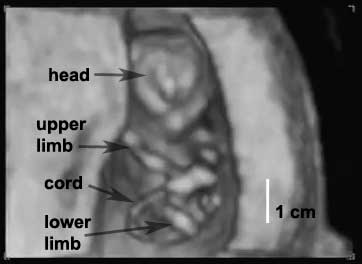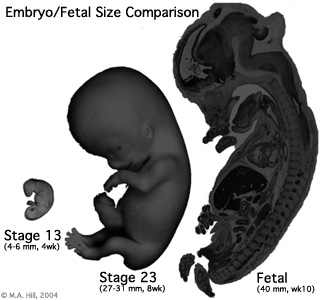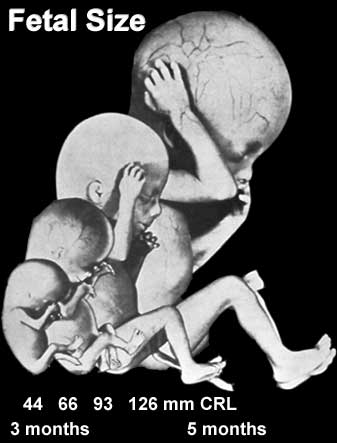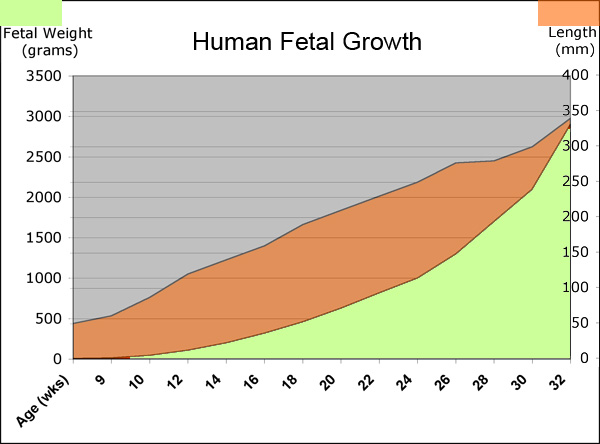Foundations Practical - Week 9 to 36: Difference between revisions
| Line 45: | Line 45: | ||
* '''High birth weights''' (macrosomia) can be an indicator of unregulated maternal diabetes. | * '''High birth weights''' (macrosomia) can be an indicator of unregulated maternal diabetes. | ||
* '''Fetal origins hypothesis''' identifies maternal derived abnormalities relate to lifestyle, environment and nutrition and while some of these directly effect embryonic development, there is also growing evidence that some effects are more subtle and relate to later life health events, originally called the "Barker Hypothesis". (More? [http://embryology.med.unsw.edu.au/Defect/page10.htm Fetal Origins or Fetal Programming Hypothesis]) | * '''Fetal origins hypothesis''' identifies maternal derived abnormalities relate to lifestyle, environment and nutrition and while some of these directly effect embryonic development, there is also growing evidence that some effects are more subtle and relate to later life health events, originally called the "Barker Hypothesis". (More? [http://embryology.med.unsw.edu.au/Defect/page10.htm Fetal Origins or Fetal Programming Hypothesis]) | ||
== 10 Week 40mm Fetus == | |||
This page is a link to images from a 10 week female fetus approximately 40 mm in size. This is showing an early stage of fetal development after the embryonic period (up to week 8). | |||
[[Image:planesm.jpg]] | |||
There are 4 sections taken in the parasagittal and sagittal plane (moving from the right at '''Plane A''' towards the midline at '''Plane D'''). Click on the small images (or the text below) to open the linked large image pages. | |||
<div align="right">[../wwwhuman/Hum10wk/HumA.htm 10 Week Plane A] | [../wwwhuman/Hum10wk/HumB.htm 10 Week Plane B] | [../wwwhuman/Hum10wk/HumC.htm 10 Week Plane C] | [../wwwhuman/Hum10wk/HumD.htm 10 Week Plane D]</div> | |||
(More? [../week/weekbyweek.htm Week by Week] | [../Movies/Humemb.htm human embryology movies]) | |||
== Terms == | == Terms == | ||
Revision as of 14:08, 27 April 2010
The Fetal Period
- Growth and organ differentiation.
The fetal period is about continued differentiation of organs and tissues, most importantly this period is about growth both in size and weight.
Fetal Development - Page with an animation covering the fetal period showing changing proportions, not size, of the fetus.
The cartoon shows changes in the relative proportions of head and body and growth of the limbs, it does not show the overall growth in size.
Many different systems formed in the embryonic period (organogensesis) grow and differentiate further during the fetal period and do so at different times.
For example, the brain continues to grow and develop extensively during this period (and postnatally), the respiratory system differentiates (and completes only just before birth), the urogenital system further differentiates between male/female, endocrine and gastrointestinal tract begins to function.
Finally consider the systems (for example respiratory, cardiac, neural) that will still not have their final organization and function determined until after birth.
Human 12 Week 4D
Fetal Growth
- First Trimester (1 - 12 weeks) - embryonic and early fetal
- Second Trimester (13 - 24 weeks) - organ development function and growth
- Third Trimester (25 - 40 weeks) - organ function and rapid growth
Embryo/Fetus Size Comparison
This is an enlarged image of the actual size comparison shown in the introduction of the Embryonic stage 13, 23 and Fetal stage 10 week 40mm.
Fetal Length and Weight
Graph shows average Human Fetal Growth from Week 9 to 36. Weight is measured in grams, Length is crown/rump in millimeters.
During the fetal period there is a separation in changes in length and weight.
- Fetal length change is greatest in the middle period (second trimester) (More? Fetal Length)
- Fetal weight change is greatest in the final weeks of development (third trimester) (More? Fetal Weight)
- Low birth weights can be an indicator of intrauterine growth restriction or retardation (IUGR), where the fetus that has not reached its growth potential because of genetic or environmental factors (less than 10th percentile for gestational age).
- High birth weights (macrosomia) can be an indicator of unregulated maternal diabetes.
- Fetal origins hypothesis identifies maternal derived abnormalities relate to lifestyle, environment and nutrition and while some of these directly effect embryonic development, there is also growing evidence that some effects are more subtle and relate to later life health events, originally called the "Barker Hypothesis". (More? Fetal Origins or Fetal Programming Hypothesis)
10 Week 40mm Fetus
This page is a link to images from a 10 week female fetus approximately 40 mm in size. This is showing an early stage of fetal development after the embryonic period (up to week 8).
There are 4 sections taken in the parasagittal and sagittal plane (moving from the right at Plane A towards the midline at Plane D). Click on the small images (or the text below) to open the linked large image pages.
(More? [../week/weekbyweek.htm Week by Week] | [../Movies/Humemb.htm human embryology movies])
Terms
- fetal length - The measurement of crown to rump length of the developing fetus. The greatest growth in length occurs in the middle second trimester, of human development. There are a number of other growth parameters that can be measured, commonly determined by ultrasound, during the fetal period. (More? Fetal Development)
- fetal period - In humans, the development week 9 to 36 is the fetal stage (second and third trimester) and during this time organs formed in the embryonic period continue to develop and the fetus grows in size and weight. The first 8 weeks of development is considered the embryonic period and is divided into 23 Carnegie stages based upon developmental milestones. Note when searching an alternate spelling "foetal". (More? Fetal Development)
- fetal weight - The measurement of the weight of the developing fetus. The measurement is obtained by ultrasound calculation or clinically estimated by palpatation. The greatest addition of fetal weight occurs during and towards the end of the third trimester. (More? Fetal Development | Fetal Weight | Ultrasound Measurements | Ultrasound Movies)
- intrauterine growth restriction - (IUGR) Term used to descibe clinically a fetus that has not reached its growth potential because of genetic or environmental factors. Abnormal development measured as less than 10th percentile for gestational age, not easy to detect before 32 weeks. This poor fetal growth can have fetal, placental or maternal causes. (More?Fetal Development | Abnormal Notes IUGR | Human Fetal Weight | Fetal Length | Fetal Programming Hypothesis | Medline Plus - IUGR)
- macrosomia - Term used to describe a newborn with an excessive birth weight. The definition is either a birth weight of 4000 to 4500 g (8 lb 13 oz to 9 lb 15 oz) or greater than 90% for gestational age after correcting for neonatal sex and ethnicity. (More? Human Fetal Weight | Maternal Diabetes)
- ponderal index (PI) - Fetal calculation based upon ratio of body weight to length PI = [weight (in g) x 100] √∑ [length (in cm)] (More?Fetal Development)
- ultrasound - A noninvasive technique for visualizing the follicles in the ovaries and the gestational sac or fetus in the [U.htm#uterus uterus]. Uses high-frequency sound waves that are reflected off internal structures. These reflections can be analysed and displayed by computer. (More?Ultrasound Measurements | Ultrasound Movies | Abnormal Ultrasound Movies)
- very low birth weight - (VLBW) This is defined as weight at birth of less than 1500 grams (3 lb, 5 oz). (More? Human Fetal Weight | Abnormal Notes IUGR)
Foundations Practical: Introduction | Week 1 and 2 | Week 3 and 4 | Week 1 to 8 | Week 9 to 36 | Neonatal | Critical Periods | Additional Resources | Quiz
Glossary: A | B | C | D | E | F | G | H | I | J | K | L | M | N | O | P | Q | R | S | T | U | V | W | X | Y | Z | Numbers
Cite this page: Hill, M.A. (2024, April 16) Embryology Foundations Practical - Week 9 to 36. Retrieved from https://embryology.med.unsw.edu.au/embryology/index.php/Foundations_Practical_-_Week_9_to_36
- © Dr Mark Hill 2024, UNSW Embryology ISBN: 978 0 7334 2609 4 - UNSW CRICOS Provider Code No. 00098G



